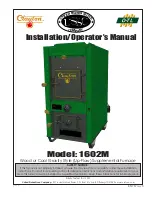
THB & TLB
Oil Furnaces
–
Furnace Manual
670-000-005/1010
21
10
Service and maintenance
(continued)
Service/maintenance procedures
To lubricate and inspect blower motor
DO NOT over-oil motors. Adding too much oil can
damage the motor bearings, resulting in blower
motor failure.
Belt-drive motor – Oil annually using 3 drops of S.A.E. #10 oil (or
other if specified by motor manufacturer). Blower bearings are
permanently lubricated and do not require oiling. Verify that the
blower, motor pulleys and belt are in good condition. Replace if
necessary.
Direct-drive motor – Oil annually using 2 drops of S.A.E. #10 oil (or
other if specified by motor manufacturer). Oiling is normally not
required until beginning of third year of operation.
Clean blower wheel – Vacuum dust from blower wheel blades and
surrounding area.
To clean heat exchanger
The heat exchanger must be cleaned and inspected
at least once each year. Operating the furnace with
a fouled or leaking heat exchanger could result in
severe personal injury, death or substantial property
damage.
The combustion chamber contains ceramic fiber
materials. Wear a NIOSH-approved respirator while
cleaning the furnace and follow WARNING on page
20 for proper handling.
1. Remove the burner and mounting plate.
2. Inspect the heat exchanger using a mirror inserted through the
burner opening.
3. Using a brush on a flexible handle, loosen the soot on the inside
of the heat exchanger.
4. Remove the soot with a vacuum. Be careful not to damage the
combustion chamber while cleaning the heat exchanger.
5. Remove the heat exchanger cleanout covers of flue collector
box. Using a brush on a flexible handle, loosen the soot from the
heat exchanger surfaces. Remove as much soot as possible
using a vacuum.
6. Replace cleanout covers.
7. Inspect combustion chamber and replace with a new one if
chamber is damaged in any way.
8. Re-install burner and mounting plate.
Obtain gas-tight seal at burner flange and cleanout
plates to prevent possible flue gas leakage and
carbon monoxide emissions, leading to severe
personal injury or death.
Inspect vent system
Thoroughly inspect the entire vent system at least annually,
including horizontal vent pipe and chimney or vertical vent. Ensure
vent system is repaired or replaced if necessary before placing
furnace in operation.
Oiled-bearing burner motors
The burner may need to be lubricated if motor is equipped with oiling
cups. Refer to burner manual for specific instructions. If instructed,
apply a few drops only of S.A.E. 20 detergent oil (never use
household oils). Do not attempt to “fill up” the oil cup. Over-oiling can
damage the motor.
Annual start up
Follow information below to prevent severe personal
injury, death or substantial property damage:
•
Do not use gasoline, crankcase drainings or any oil
containing gasoline. See burner manual for proper
fuel oil.
•
Do not attempt to start burner when excess oil has
accumulated, when unit is full or vapor or when
combustion chamber is very hot.
•
Do not start burner unless collector box, vent and
burner mounting door are secured in place.
•
Never burn garbage or paper in the furnace.
•
Never leave combustible material around it.
To start furnace
1. Factory burner adjustment and settings may not be suitable for
specific job conditions. Refer to burner manual for burner start
up, adjustment and checkout procedures.
2. Set room thermostat to call for heat.
3. Refer to burner manual for start up.
4. The furnace blower will delay for a short after burner starts, until
the limit/fan switch senses air temperature above the fan ON
setting.
5. Set room thermostat to its lowest setting. Burner should turn off.
6. Furnace blower will continue to run until the limit/fan switch
senses air temperature below the fan OFF setting.
7. Set the room thermostat to call for heat again. Allow furnace to
heat to design temperature. Then adjust burner for correct
combustion, using combustion test equipment. Adjust burner for:
Draft: -0.01 to –0.02 inches water column draft in furnace
combustion chamber.
CO
2
: between 10 % and 11 ½ %, with 0 smoke.
Make final burner adjustments using combustion test
equipment to assure proper operation.
8. Check furnace and duct system for proper operation and
conditions.
9. Inspect vent system for proper operation.
10. To set limit/fan switch:
The blower operates until the air temperature drops below the
fan OFF setting. If the air at the supply registers is too warm at
blower start up or shutdown, lower the fan OFF and ON settings
on the limit/fan switch.
To check operation of the limit switch, slide a piece of cardboard
into the furnace filter slot. After a few minutes of operation (not
more than 5 minutes), the burner should shut off (limit switch
open). The blower will operate until the furnace cools down.
Remove cardboard when finished.
11. Complete testing of the burner cad cell control using the
instructions in the burner manual.
Содержание THB High Boy series
Страница 35: ......
Страница 36: ...THB TLB Oil Furnaces Furnace Manual X40108 Rev J ...













































